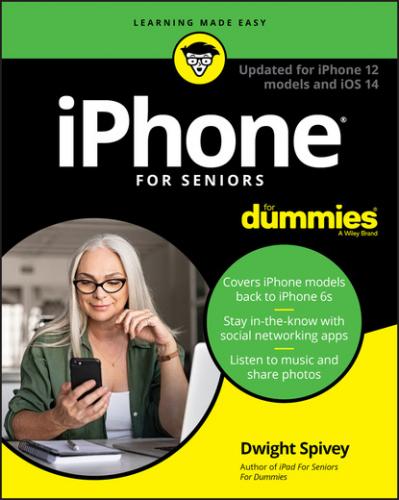MagSafe charging: iPhone 12 models include MagSafe charging, which uses Apple’s MagSafe technology to charge your iPhone with a magnetic connector that snaps onto the back of the device. Apple also has a series of accessories, such as cases and wallets, that are MagSafe compatible, meaning you can charge your iPhone even if has those accessories attached.
Ceramic Shield: The toughness and durability of Apple’s screens just keeps getting better. Ceramic Shield was developed by Apple and Corning, and according to them, it’s the toughest screen ever for a smartphone, making it four times more likely than other smartphones to survive a drop unscathed.
Any iPhone model from the iPhone SE (1st generation) forward can use most features of iOS 14 if you update the operating system (discussed in detail in Chapter 3); this book is based on version 14 of iOS. This update to the operating system adds many features, including (but definitely not limited to) the following:
Home screen enhancements: Your Home screens are where all your apps are organized. iOS 14 introduces features such as App Library, the ability to hide entire Home screen pages, and enhanced widgets.
Siri improvements: Siri just keeps getting better. Siri can now speak in more languages and voices, send audio messages, and includes 20 times more facts than in previous iterations. Siri also has a more compact presence on your screen, so the entire screen isn’t taken up when using the feature.
Widgets: With iOS 14, you can now place widgets on your Home screen. Widgets are snippets of information, such as weather and calendar appointments, that are provided at a glance so that you don’t have to open individual apps. Widgets were once only available on the Today screen, but now you can place them anywhere you like, and you can also customize their size and appearance.
App Library: The App Library affords you a new way to organize and access your apps, alongside the traditional way of doing so with your Home screen(s). Apps are automatically organized in the App Library according to category.
Compact Calls and Picture-In-Picture (PIP): In the “old-timey” days before iOS 14, phone calls and FaceTime calls would take up your entire screen. Now those calls only take up a small portion of your screen (if you like), allowing you to multitask while talking.
Translate: iOS 14 introduces the new Translate app. Translate allows you to carry on a conversation in 11 different languages. It also offers a mode that allows you and another person to speak to one another in your native languages while Translate instantly displays the translation for each of you. It’s almost like something out of Star Trek.
These are but a very few of the improvements made to the latest version of iOS. I suggest visiting www.apple.com/ios/ios-14 to find out more.
Choose the Right iPhone for You
The sizes of the latest iPhone 12 models vary:
iPhone 12 measures 2.82” by 5.78” (6.1” diagonally) with a depth of .29 inches (see Figure 1-1).
iPhone 12 mini measures 2.53” by 5.18” (5.4” diagonally) with a depth of .29 inches (also shown in Figure 1-1).
iPhone 12 Pro measures 2.82” by 5.78” (6.1” diagonally) with a depth of .29 inches (see Figure 1-2).
iPhone 12 Pro Max measures 3.07” by 6.33” (6.7” diagonally) with a depth of .29 inches (also shown in Figure 1-2).
You can get iPhone 12 in white, black, blue, green, and a beautiful PRODUCT RED version. iPhone 12 Pro and 12 Pro Max both come in gold, silver, graphite, and a great-looking Pacific Blue.
Other differences between iPhone models come primarily from the current operating system, iOS 14.
Not sure whether to get an iPhone 12 model? Here are a few more key differences:
The battery life of the iPhone 12 Pro Max is longer than the other models. For example, audio playback time on the 12 Pro Max is rated at 80 hours versus 65 hours on the 12 and 12 Pro, with the 12 mini maxing out at 50 hours.
iPhone 12 Pro and 12 Pro Max have triple rear-facing cameras, providing amazing optical zoom, Portrait mode, and other features. The 12 and 12 mini has dual rear-facing cameras.
Screen resolution: The higher the resolution, the crisper the phone display. The iPhone 12 and 12 Pro provide 2532 x 1170 resolution; 12 mini boasts 2340 x 1080; and 12 Pro Max provides a stunning 2778 x 1284.
Table 1-1 gives you a quick comparison of iPhone XR, 11, SE (2nd generation), 12, 12 mini, 12 Pro, and 12 Pro Max (models currently sold by Apple). All costs are as of the time this book was written. (Some carriers may introduce non-contract terms.)
TABLE 1-1 iPhone Model Comparison
| Model | Storage | Cost (may vary by carrier) | Carriers |
|---|---|---|---|
| XR | 64 and 128GB | from $499 | AT&T, Verizon, Sprint, T-Mobile |
| 11 | 64, 128, and 256GB | from $599 | AT&T, Verizon, Sprint, T-Mobile |
| SE (2nd generation) | 64, 128, and 256GB | from $399 | AT&T, Verizon, Sprint, T-Mobile |
| 12 |
